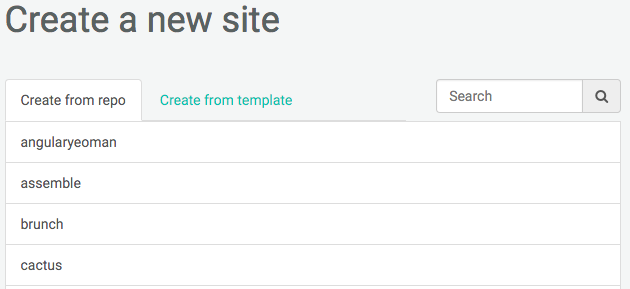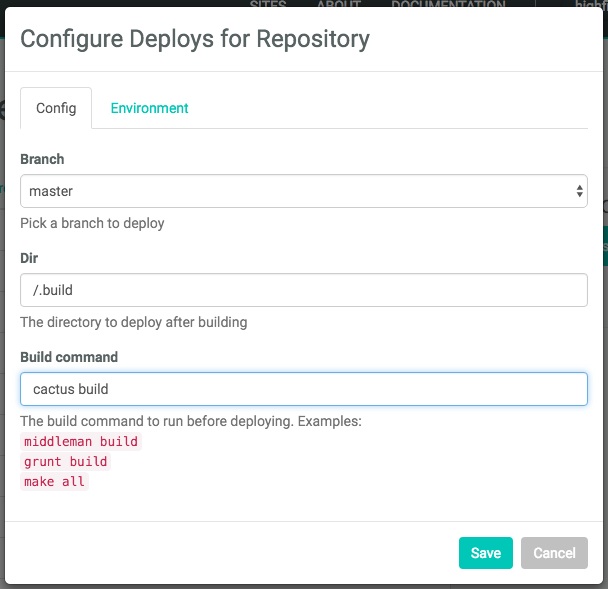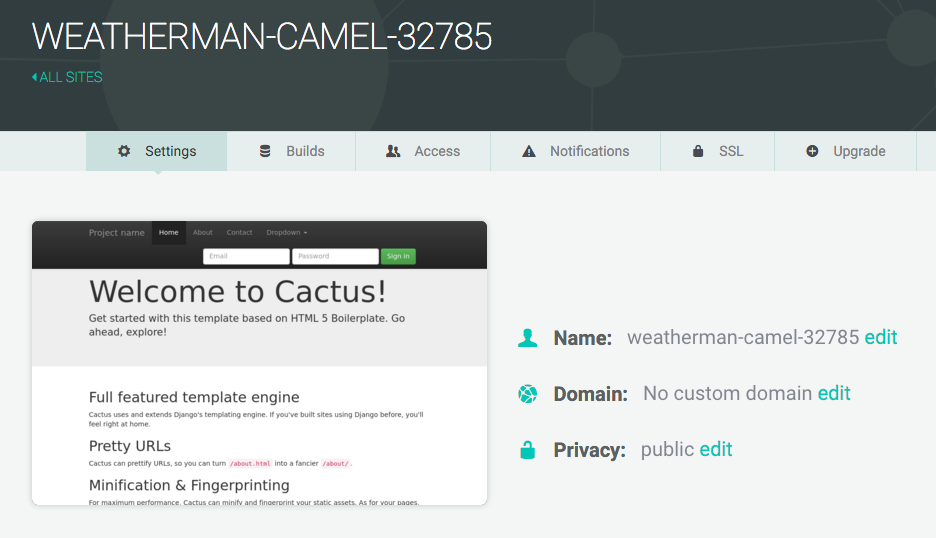Let’s take a look at building a site with Cactus, including continuous deployment.
Cactus is a modern build tool that runs on Python and uses Django’s templating engine. Cactus has a lot of tricks up its sleeve, and even has a Mac app.
The app doesn’t work out of the box with Netlify, so there are a few quick changes you’ll need to make before you can deploy. Jump to Created with Cactus App to make those changes.
If you’ve already built your Cactus site, you can jump down to Connecting to Netlify.
Installing Cactus
This guide assumes you have Python installed.
Open your terminal, and enter the following command:
$ pip install virtualenv
Installing virtualenv will allow you to easily control all the dependencies needed for your project (or any Python project). This way, we can make sure that what you see when you build your Cactus site on your local machine is exactly what you see when you host that site on Netlify.
Let’s get your workstation prepped. Use virtualenv to create the cactus directory where you’ll be working:
$ virtualenv ~/PATH/TO/cactus
$ cd ~/PATH/TO/cactus
$ source bin/activate
Now you can install Cactus
$ sudo easy_install cactus
Building Your Site
Now that you are in your virtualenv and have cactus installed, it’s time to put your site framework in place. do that with the following command:
$ cactus create ~/my-site
This creates a directory called my-site inside the cactus directory, which you’ve set up as a virtualenv.
Change to the my-site directory with this command
$ cd my-site
Cactus has already built you a dummy site with a directory and file framework, so you can test it out immediately. Run cactus as a local server with this command
$ cactus serve
This will generate your site in simple HTML format in ~/my-site/.build
Now you can view your site by visiting http://localhost:8000 in your browser.
Like what you see? Great. Let’s move on!
Preparing for Deployment
If you are satisfied with your site, it’s time to get it ready to deploy. First, let’s make sure that Cactus and GitHub will play nicely together.
Cactus generates your website to the .build directory. We want to make sure that the .build directory is not version controlled by Git, so we’ll create a .gitignore file in the root directory and add .build to it:
$ echo "/.build" >> .gitignore
We also want to make sure that Netlify knows exactly which versions of various Python plugins you are using. We can do that by creating a file called requirements.txt
$ pip freeze > requirements.txt
Okay, you’re ready to go!
Now it’s time to push it to your repo of choice. What follows are directions for users of the CactusforMac app. You don’t need them, so you can jump down to Creating Your Git Repo.
Created with Cactus App
If you created your site with the CactusforMac app, you know that it’s set up out of the box to build on your machine and deploy to Amazon’s S3. With Netlify, the site will actually be built on our server (so that we can optimize it, making it lighter, smaller and faster) so you’ll need to make a few changes before you can launch the site.
First, navigate to the folder where your site lives. If you used the app’s normal naming structure, it will be named something like My Blog Site. Python doesn’t like spaces, so rename that folder to something like my-site.
Next, open that folder and create a new file, and name it .gitignore
Open .gitignore in your text editor, and paste in the following
/.build
**/*.pyc
*-env/
Finally, Netlify needs to know what tools to use to build your site. Create a file called requirements.txt and paste in the following line
Cactus==3.3.3
That’s all you have to do. Now it’s time to push to GitHub.
Creating your Git Repo
Create a new repository on GitHub. To avoid errors, do not initialize the new repository with README, license, or gitignore files. You can add these files after your project has been pushed to GitHub.
Open the terminal.
Change the current working directory to your local project.
$ cd ~/PATH/TO/my-site
Initialize the local directory as a Git repository.
$ git init
Add the files in your new local repository. This stages them for the first commit.
$ git add .
Commit the files that you’ve staged in your local repository.
$ git commit -m 'First commit'
At the top of your GitHub repository’s Quick Setup page, click the clipboard icon to copy the remote repository URL.
In Terminal, add the URL for the remote repository where your local repository will be pushed.
git remote add origin GIT_REPOSITORY_URL
Verify your URL
git remote -v
Now, it’s time to push the changes in your local repository to GitHub.
git push origin master
Now that your assets are up and running on GitHub, let’s connect them to Netlify.
Connecting to Netlify
Step 1: Add Your New Site
 Creating a new site on Netlify is simple. Once you’ve logged in, you’ll be taken to https://app.netlify.com/sites. If you’re just starting out, there’s only one option.
Creating a new site on Netlify is simple. Once you’ve logged in, you’ll be taken to https://app.netlify.com/sites. If you’re just starting out, there’s only one option.
Step 2: Link to Your GitHub
Clicking “New Site” brings you to this screen:

When you push to GitHub, Netlify does all the work. No more manual deploying of updates or changes!
Since your assets are hosted on GitHub, we’ll need to link Netlify to GitHub. Click “Link to GitHub”.
Step 3: Authorize Netlify

It’s time to allow Netlify and GitHub to talk to each other. Clicking the “Authorize Application” button will do just that. Like it says in the image below, Netlify doesn’t store your GitHub access token on our servers. If you’d like to know more about the permissions Netlify requests and why we need them, you can visit our documentation on Git provider permissions.
Step 4: Choose Your Repo

Now that you’ve connected Netlify and GitHub, you can see a list of your Git repos. There’s the “cactus” repo we just pushed to GitHub. Let’s select it.
Step 5: Configure Your Settings

Here you can configure your options. Be sure your settings match the screenshot above, with /.build as the directory and cactus build as the build command.
Step 6: Build Your Site

Now it’s time to sit back and relax. Netlify will build and optimize your site, and you can watch the progress.
Step 7: Done

Wait, you thought there was going to be more? Nope! Netlify has done it all for you, including giving your site a temporary name. Your site is now live. Congratulations, and thanks for using Netlify!




